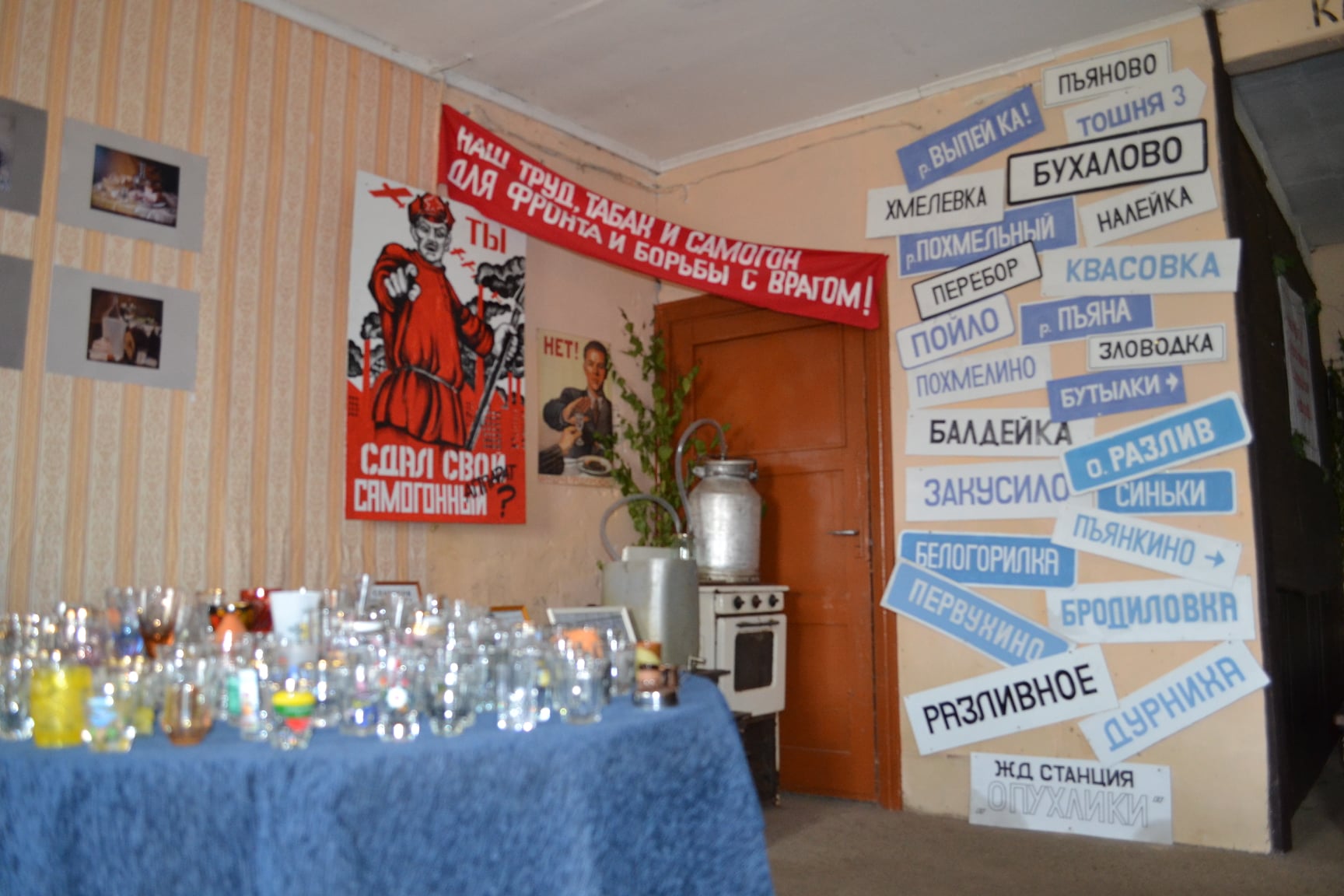by Will Mawhood, RĒZEKNE
Gunārs Igaunis, dressed in a vermilion smock over blue jeans, offers me a home-grown pear then throws open the door of the barn in his rambling garden. Inside is a narrow, lime-green room, set about with shelves of different sizes and heights, all crowded with vials, lamps, flasks and bottles, milk pails, twisty-turny pipes and funnels, looping rubber tubes and knick-knacks of various description.
We’re in the tiny village of Gaigalava, in the heart of the eastern Latvian province of Latgale. And this is the Museum of Šmakouka, dedicated to the production and consumption of šmakovka, one of many terms by which home-brewed alcohol is known in these parts (The spelling used by Igaunis, the museum’s proprietor, reflects one particular regional pronunciation of this word).
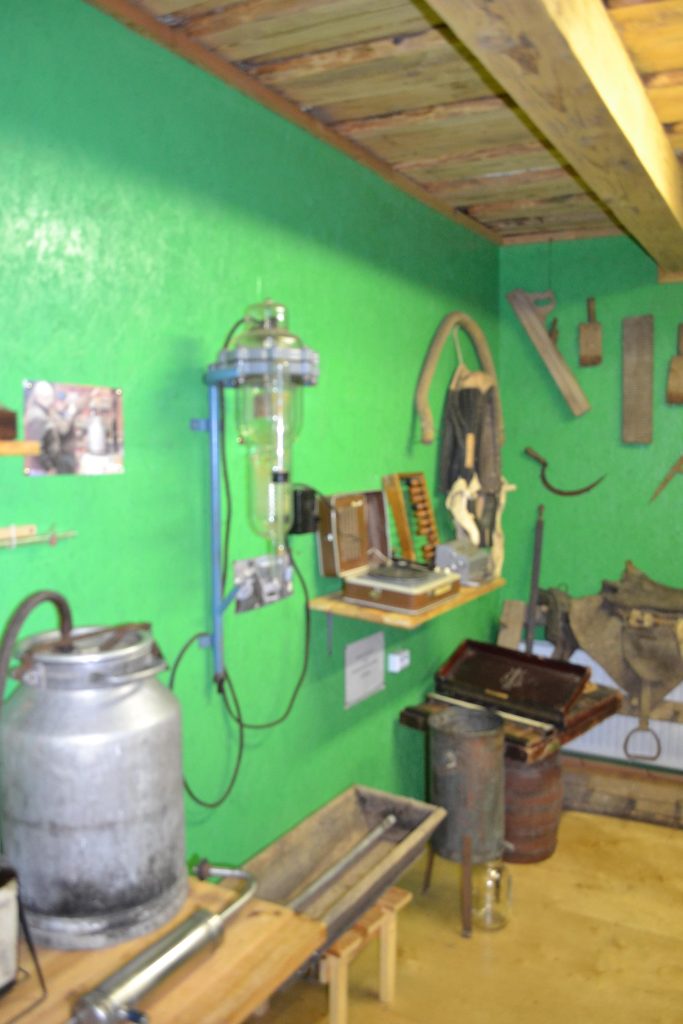
This is one of two museums in Igaunis’s garden (the other one is dedicated to musical instruments). And, perhaps even more extraordinarily, this is just one of a total of four museums dedicated to šmakovka throughout Latgale, the easternmost and most anomalous of Latvia’s four historical regions. Igaunis himself, a cheery and animated figure who is mostly known as a musician, is also a small-scale distiller.
It was tricky – and bumpy to get out here. From the central Latgalian city of Rēzekne, where I’ve been staying, it took over an hour to cover the 20 or so kilometres to Gaigalava. After a lengthy stop in the mid-sized town of Viļāni, we plunged into deep country, following mostly unpaved roads; on a map these look just like running cracks in an old wall. The little minibus threw up dust as we went. As we approached the marshes that fringe out from Lake Lubāns, Latvia’s largest by area, I watched as the watery land flashed unexpectedly in the gentle sunlight. The chatter I could hear around me, from old ladies and children alike, was almost exclusively in Russian.
Gaigalava itself is a former kolkhoz settlement, straggling between a remarkable Soviet-era municipal building, bulky but angular like it’s wearing shoulder pads, and a white Catholic church with two sharp towers. When we arrive there’s a tractor drawn up outside the municipal building, harrow attached; Igaunis’s house is just opposite, down a long drive festooned with signs advertising his museums.
Once inside the barn, I get a crash course in making moonshine Latgale-style.
First, Igaunis explains, a mash is created by adding water to whatever substance has been chosen as a base, and then combining it with yeast – under Communism sugar was used most often in Latgale, being easier to get hold of than grain. (When Gorbachev attempted to crack down on alcohol consumption from 1985 onwards, sugar and even sweets abruptly vanished from shelves throughout the Soviet Union). Once the mash has fermented, a process that usually takes several days and sometimes over a week, it is heated. Alcohol has a lower boiling point than water, and so if the resulting vapour can be rapidly cooled and the initial, highly potent and highly hazardous, few drops can be siphoned off, the liquid that eventually drips out should be powerful and drinkable stuff.
This means that all that is needed to brew your own high-proof spirits – at least if you’re relatively indifferent to quality and safety – is a container that can withstand heat and a tube of some kind, both things that the average farmyard or mechanic’s should have in profusion.
And sure enough, scattered about the room are testaments to the imagination and resourcefulness of rural Latgalians in pursuit of moonshine: there’s what seems to be a metal rubbish bin with pipes attached, devices for milking cows, bits and bobs appropriated from the internal workings of cars and motorbikes, a pig trough, pots and pans, barrels with attached spigots, and many, many glasses. For those of a more conventionally scientific bent, there are test tubes, round-bottom flasks and retort stands too.
Igaunis also shows me the oldest way of brewing moonshine, which dispenses even with the pipe. A bowl is placed in a barrel containing mash, below a much larger basin filled with cold water or snow; heat is applied, and the vapour rises, condenses and drops down again. The water in the basin above is regularly replenished so it remains cool, and the process continues until the mixture in the bowl is sufficiently full of head-spinning liquid. This is how his grandparents made moonshine, he says: with a large metal pot standing in for the barrel, and using for their mash sugar beets liberated from the kolkhoz.
So just why is it that Latgale specifically has become so associated with homebrew?
Igaunis replies by way of an allusion to one of the numerous characteristics that marks Latgale out from the other three historical regions of Latvia – its much greater influence from the Slavic neighbours who have long lived alongside or among them.
“The tradition came from Russia, Belarus, Ukraine…”, he explains. Those easterners who came to this eastern part of Latvia introduced their distillation techniques, and taught the locals. The brewing traditions that came from Scandinavia or Germany, which may have been influential to their north and west, Latgalians were much less exposed to.
I think back to the night before in Rēzekne. I had popped in for a beer at a cosy place tucked underneath the Soviet-era block of flats where I was staying. What I was presented with was a perfect microcosm of multicultural Latgale – a microcosm that became still more perfect as the night went on. The two bartenders spoke to each other in Latvian, but the younger one, who couldn’t be much out of his teens, mentioned that the language he spoke at home was actually Polish. The other, in his late thirties, told me that between themselves his parents conversed in Latgalian, but that they always addressed him in Latvian. Later, a few people entered and ordered in Russian and the bartenders switched to that language with no apparent strain in accents or conduct, which wouldn’t be the case among young people everywhere in Latvia.
This striking multiculturalism is the fruit of a history that differs markedly from the other three Latvian provinces, Vidzeme, Kurzeme and Zemgale.
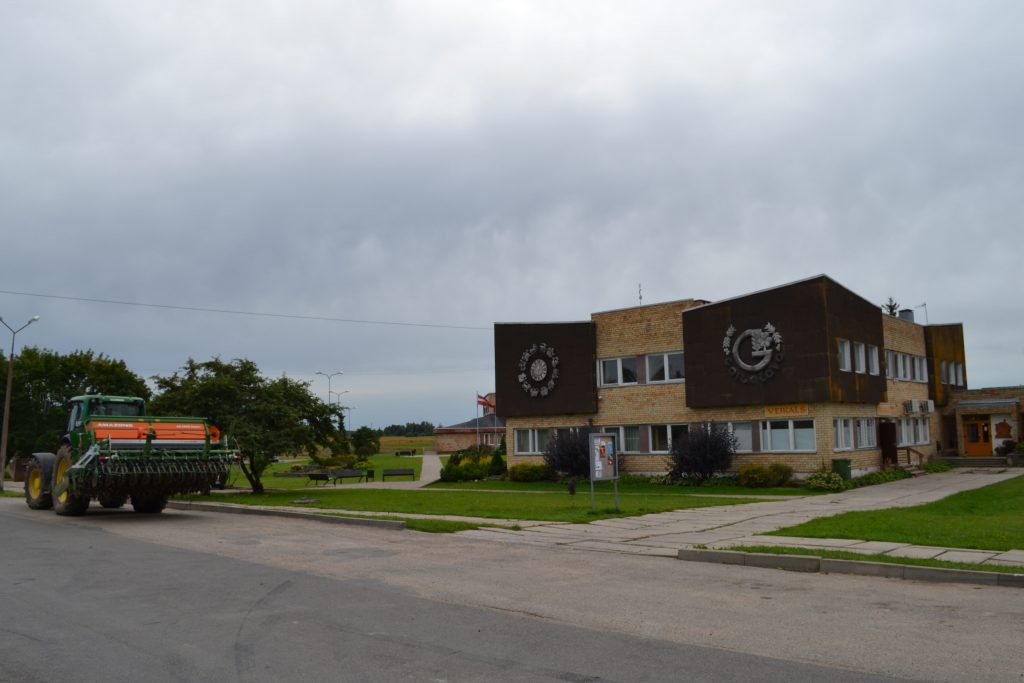
During the hundred years and more when Riga and northern Latvia was under Swedish rule, Latgale was a far-flung province of the Polish-Lithuanian Commonwealth. Then and thereafter, landowners were largely Polish, rather than German as in the rest of Latvia, and the dominant denomination remained Catholicism as the other Latvian regions turned to Lutheranism. Later, under the Russian Empire, while almost all of present-day Latvia was governed from Riga or the nearby city of Jelgava, Latgale formed part of a governorate with its administrative centre in Vitebsk, now in Belarus, and thus with substantially different laws (including falling within the Pale of Settlement).
The rural Russians I overheard on the bus produced a little cognitive dissonance: Russian is very much an urban language in the rest of Latvia, spoken mostly by descendants of the hundreds of thousands who came to work in the republic’s factories after its occupation by the Soviet Union. But many, if not most Russian-speakers in rural Latgale have roots that go much further back – a good number descend from Old Believers who fled Russia centuries ago, for Estonia and eastern Latvia, at that time beyond the empire’s bounds, having refused to accept changes to the Orthodox liturgy made by the Tsar.
The Latgalians have historically called their fellow Latvian-speakers across the River Aiviekste baļtīši (Balts) or more derogatorily, čiuļi, and traces from their centuries apart were and still are very palpable (and audible). Latgalian, which is spoken through much of the region, is considered in law to be “a historic variant of the Latvian language”, but differs so much from the standard that it can befuddle Rigans and is often claimed to be a separate language (it has its own orthography, too, including letters like “y” that do not appear in Latvian). Social conditions can often differ too: unemployment in Latgale generally hovers around double the national rate – as of writing it’s slightly over 15%.
The powers that have controlled Latgale have been variegated in ideology and priorities, they have stretched their authority out from different capitals, but they’ve been united by their desire (at least officially) to stamp out the covert alcohol production that has so long characterised the region.
Most recently, and well within Igaunis’s memory, the foreign power was the Soviet Union. While home brewing was not legal, the Soviet state unofficially encouraged alcohol consumption as a crucial source of revenue for the state and its creaking economy – and it was highly effective: annual consumption doubled between the mid-’50s and the end of the 1970s, with the average person putting away over 15 litres a year. The disastrous social, health and productivity consequences of this were what prompted Gorbachev to launch his war on alcohol, sharply hiking prices and banning sales after 2 p.m. While this did lead to a decrease in alcohol consumption, there was a corresponding spike in illicit moonshine production, including, unusually, in urban areas.
Did the Soviet authorities know what was going on, how the regulations against home brewing and distillation were being flouted in Latgale? “They knew, and they did it themselves, but they pretended they didn’t know”, Igaunis replies. “Everyone made their own moonshine – absolutely everyone”. Money had little worth under Soviet rule, and so one of the makeshift currencies pressed into use was the bottle. Moonshine paid for moonlighting – if you wanted an electric cable fixed or your crops harvested, and you wanted it done fast or cheaply or at least outside the rigid official system, this was how you would tempt out the experts in question.
“Everyone who was a specialist was a big drinker”, Igaunis tells me.
Latvia is now the only country in northern Europe that allows home production and selling of alcohol, under a special licence for small-scale distillers like Igaunis, although there are various limitations. He can only use base ingredients that he grows on his own property and can produce no more than 1,000 litres of absolute alcohol per annum.
I try some of the products he makes here. First, “in honour of Covid”, we get a 70% apple moonshine, which he first sprays on his hands, a disinfectant that even the virus that has brought the world to its knees would struggle to endure. There’s a much milder blueberry of just 30%, made from last year’s berries, then one from cherries. Last, and my favourite, he gives me a shot made up of a melange of different berries, distilled from jam. It seems made up of little shards of different flavours, nothing I would be able to tease out. Despite its subtlety and interlacing layers, it’s powerful enough to warm the gullet and pucker the mouth and gums for the best part of a minute afterwards.
Finally, Igaunis demonstrates the distillation process through a series of test tubes – a quick and improved gift to moonshine-makers weary of the endless cycle of the two bowls. A few minutes pass before, at the bottom of one of the pipes, a fly suspended in liquid suddenly starts to bobble around, letting us know the steam is rising and the process is now in motion even if we can’t see it.
After that I have to go for my bus. Unfortunately, in a very slightly warmed and confused state after all of those shots, I find that I’ve misread the public transport schedules and missed the last (only) bus back from Gaigalava to Rēzekne that day. So I have to run the best part of three miles along country roads to the highway, where inter-city coaches occasionally pass, the bottle of šmakovka I bought from Igaunis clinking rhythmically in my bag.
The next morning, finally back in Rēzekne, I get on a larger bus heading to the town of Kārsava, 20 miles north and a short distance from the Russian border. There, in the adjacent settlement of Malnava, a (legal and commercial) šmakovka distillery was set up in 2016.
During the patches of woodland we speed through on the way, the dimensions seem somehow stretched, a low-key rumbling beginning to the yawning spaces further east. Many of the houses we pass are wooden. Some are neatly painted, boasting ornate front porches, often with the lattice-like, paper lantern eaves typical of Latvia and Lithuania; interiors shielded by patterned lace. Among others, looking disreputable, drenched and dried by the harshness of countless winters, the wood has attained a roughness and toughness that brings to mind the matted hair of some wild, forest-dwelling animal.
I remember that a century or so back, these forests would have been pocked with secret “corner pubs” or covert stills. For just like the Soviet Union that forcibly dissolved it in 1940, the interwar Republic of Latvia had also fought its own battle against the unlabelled bottle, and resistance was fiercest of all in Latgale.

“The countryside and towns of Latgale are spread over, as though by a fine spider’s web, with the production of different kinds of surrogate alcohol. They produce both home-made vodka, and “kumuška” – or home-made beer – about which we Balts do not have the slightest idea.”
That was one Čivlis, writing in the interwar period. Kumuška, he said, was brewed from sugar, yeast, raisins and rye flour. A handful of coins could buy you five bottles – enough to knock out two people, as various intoxicating herbs such as marsh tea, henbane and great mullein were invariably added during the fermentation process.
When the Latvian constitution was drawn up in 1920, there was considerable support in the Saeima (Latvian parliament) for bringing in complete prohibition, as the US had done earlier that year. In the end, moderate alcohol consumption and production was permitted, with hefty fines for appearing in public in an inebriated state and strict limitations on how close taverns could be to any government institution, church or school.
However, the distances were set so that in many rural areas legal drinking establishments were essentially prevented from existing, and, in Latgale in particular, the measures seemed counter-productive. A contemporary article from the newspaper Latgales Laiks described how this gap in the market was filled by the purveyors of illegal booze described by Čivlis, and the prisons were full of those arrested and unable or unwilling to pay the fines – the jail in the Latgalian town of Ludza, they reported, designed to accommodate 60 people, was having to house as many as 130.
We draw up in Kārsava’s small bus station, overlooked by a terracotta-coloured and vaguely Byzantine-looking domed Catholic church, right alongside a (newer-looking) wooden one, painted honey yellow. A service is just ending and the congregation, of all ages, are trickling out in dribs and drabs. I don’t have too far to walk: Malnava is separated from Kārsava by just a couple of fields, and the signs announcing the two towns sit well within eyeshot of each other. A little off the main road, the Latgalian flag – a griffin on a blue-and-white striped backdrop, adopted in the last decade – hangs limp outside a neat whitewashed building stencilled with neat black letters.

This is Latgolys Šmakovka (“Šmakovka of Latgale” in Latgalian). Just inside, there is a tidy wood-panelled bar area, lined by vintage bicycles and beneath a 1930s sign urging locals to buy Latvian products. This is clearly a larger-scale operation than any I’ve seen thus far in Latgale.
I’m greeted by founder and proprietor Jānis Krivtežs, who walks me to the back of the building. There, squat and shiny and taking up a considerable chunk of the room, is a slightly battered-looking copper pot still. Rising from its broad base up to a bulky spherical interval, reminiscent of the bulbous beads I’ve seen adorning Orthodox church spires throughout the region, it narrows again before reaching a lozenge-shaped peak, where a thin lengthways pipe connects it to a barrel alongside. It seems like a beefed-up cousin of Igaunis’s fragile test tubes and glasses, and indeed it works in essentially the same way, just at a magnified scale, heating and cooling at the right moments and dispensing with what’s not needed.
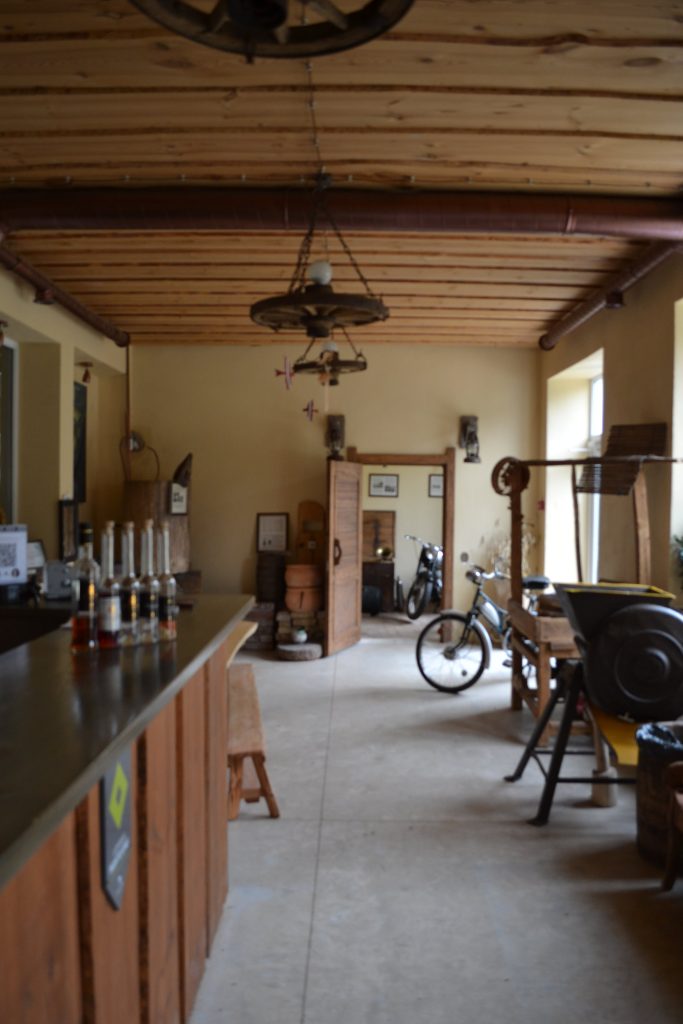
This is the biggest device of its sort in Latvia, Krivtežs tells me – before, a beat later, raising that boast considerably: “for šmakovka exactly, the biggest in the world”.
Before being converted for use by Latgolys Šmakovka, the building had been abandoned for 15 years, and during the Soviet period it had served as a dairy – “my aunt worked here”, Krivtežs tells me. For Krivtežs is a local – from Malnava itself, in fact. He left the town for study and work, but returned to his home to set up the distillery, inspired by memories of the delicious alcoholic treats his family had produced themselves from local fruit and grains and other natural ingredients. As he tells me, he sold his Rēzekne flat for 15,000 euros and bought the hulking still for 18,000.
Thanks to this still and the more extensive and technically equipped premises he meets the legal requirements for large-scale alcohol production and so is not bound by the same restrictions that apply to Gunārs Igaunis.
I get to drinking. We make it through cranberry liquor, then single-malt whiskey – in Latgale made from malt that has first been dried over a fire of alder, instead of the peat fires used in most of Scotland and Ireland. Krivtežs tells me his family often came up with something similar by distilling beer left over from the Midsummer Night celebrations. There’s a gentle, mellifluous honey wine (unlike most mead, twice distilled rather than just fermented) followed by his own Coronavirus-fighting offerings, a pungent chilli and garlic pairing and another of 70% potency that I can only respond to with a “wow” (Krivtežs slips into English to explain its Latgalian-language brand name Pļaujmašyna, which translates as ”combine harvester”, telling me “if you drink, it cuts you down”…). Unfortunately we don’t get onto the cocktail they offer, šmohito.
The products offered by Latgolys Šmakovka go some way beyond the traditional idea of šmakovka as something cooked up in a milk pail somewhere under cover of night. There is of course no specific definition of what precisely moonshine is – simply alcohol made under your own steam with your own equipment and ingredients, which is what Krivtežs is doing, albeit at a much greater scale, and with the explicit, rather than covert, consent of the state.
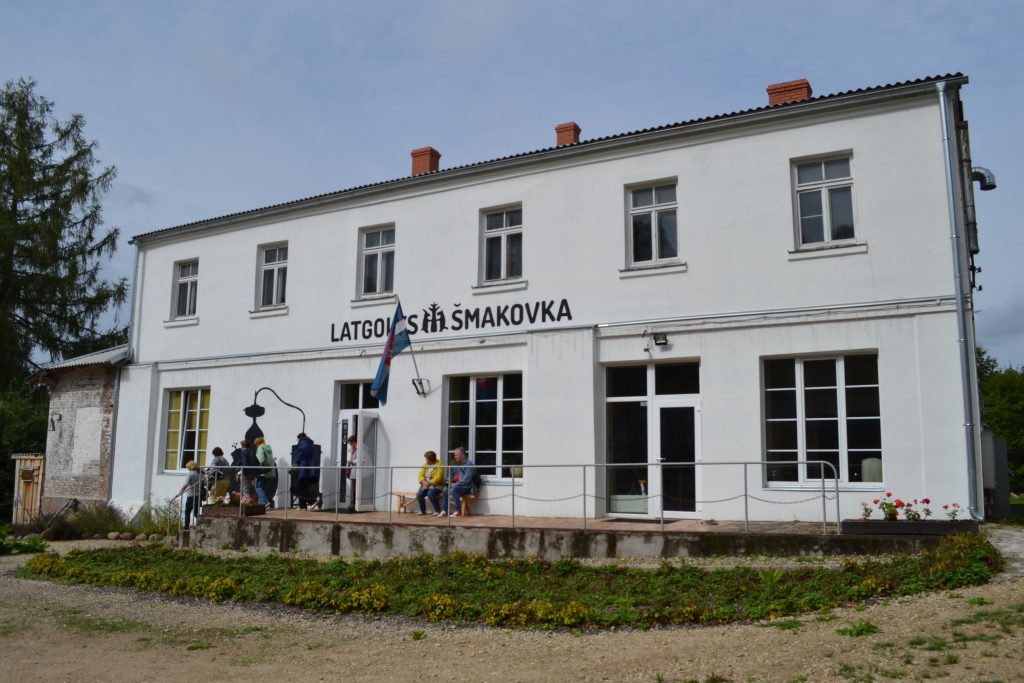
And there does appear to be a lineage here, as Krivtežs tells me. Latgolys Šmakovka is in the grounds of a pristine white-painted manor, which spreads out luxuriantly at the centre of Malnava, and was the village’s original reason for existence. For over a hundred years the manor was in the possession of the Polish Szadurski family, but it was nationalised by the new Latvian republic in 1920 and is now an agricultural college.
One member of the dynasty was a keen gardener and laid out a fruit garden, from which alcohol was often distilled. When trying the concoctions that resulted, the nobles would frequently use the word “smak”, which means, more or less, “taste” in Polish. The common people, speakers of Latgalian, misunderstood this as being a catch-all term for home-brewed alcohol, and so the name šmakovka arose.
It’s worth mentioning that some see this word as, if not a new term exactly, then an almost forgotten one that has been deliberately reintroduced. In the texts from the interwar period I read, it’s “kumuška” that is referred to as leading the Latgalian countryside to rack and ruin (although ”šmakolka”, which is presumably a variant, is mentioned in some places). “Dzimteneite”, which is a diminutive of “homeland”, is also found occasionally, both then and now. But with the arrival of the Soviets, the term “samogonka”, derived from the Russian word for moonshine, “samogon”, seems to have gradually taken over in most parts of Latgale.
A Facebook poll carried out by lakuga.lv, the main cultural website publishing exclusively in Latgalian, asked respondents what term they used when referring to moonshine. The results of this admittedly unscientific method showed that more than three times more people used “samogonka” than “šmakovka”. One user writing in Latgalian commented that he had only heard the word “šmakovka” for the first time in Riga in the 1990s; others that they first heard it on TV. (Interestingly, a third moonshine museum in the region also eschews the term, calling itself “the Museum of Kandža”, after the word for homebrew that is used in the rest of Latvia.)
I think about my visit to that museum, the first trip I took during my three days in Latgale. It’s in the picture-perfect one-street village of Kaunata, 20 kilometres south of Rēzekne alongside Lake Rāzna, and is run by Dace Zagorska, who I’m only able to track down via a mobile number posted on a website that was last updated in 2014. She’s a teacher, as she tells me on the phone, and we agree to meet just outside the village school where she works.

She walks me the five minutes to the museum, in an unmarked building under the disapproving eye of the village’s Catholic church. Long and low-slung, with the boulders and rocks it was constructed from clearly visible in the chipped and exposed outer walls, it was apparently once a pub, and after that simply abandoned. Zagorska says multiple times that she is looking for somewhere else to host her collection – but as a home for an institution dedicated to moonshine this seems hard to improve on to me.
The little space is beset with oak leaves and lined with earthy sayings in Latgalian – the most prominent one, etched across a beam, declares “when moonshine’s in the head, the brain’s in the arse”. Reproduced signs on the wall display the comical-sounding names of towns and villages in Latvia (and further afield) which have their roots in drinking, and a noticeboard features quotes related to moonshine and how its consumption improves, affects or hinders various aspects of life. There’s a vertical beam scribbled with names for šmakovka, and it covers half the space to the floor; an article I later find about moonshine in Latvia adds colourful cover names that I’ve never before come across such as “ditch wails”, “bush rustles”, “stove water” and “forest edge”
In the choice of šmakovka as a term there is the sense certainly of not an invented tradition, but one that has been carefully curated and streamlined in recent years. In an interview given to Latgales Laiks in 2017 shortly after the opening of his distillery, Krivtežs declared that “šmakovka could become a brand for the region”, and that does indeed seem to be happening. The same year, the Museum of Šmakovka opened in Daugavpils, the largest city in Latgale, given pride of place in the central Vienības nams (Unity House) alongside Daugavpils Theatre, the Latgale Central Library and the Latvian Cultural Centre. Probably the highest-profile museum to be opened in Latgale in recent years, it is clearly well-funded and has been at the forefront of promoting moonshine as a symbol of the region.
Through videos made available on YouTube and an active social media presence, they promote the “šmakovka trail”, covering all four of the region’s museums. There’s even a “šmakovka laboratory” producing and serving the drink, which seems to have sprung up in the last year and is attached to a rather fancy-looking hotel on the banks of the River Daugava not far from Daugavpils. The videos I watch are partially narrated in a deliberately folksy but easily comprehensible Latgalian and set to a cheery folk-pop soundtrack, playing on national perceptions of Latgalians as both rustic and blunt. One video refers to šmakovka as dzidra kā avota ūdens, un stipra kā darbā rūdīta lauka vīra rokasspiediens – “clear as spring water, and strong as a handshake from a work-toughened countryman”

But just as marketing agencies wake up to the commercial possibilities of promoting šmakovka and its vibe of rollicking law-flouting and tipsy good cheer, it’s quite possible that the culture of under-the-counter brewing and selling that outlived the Soviet Union may be staggering towards a total collapse. Alex Krasnitsky, the editor-in-chief of the Russian-language version of Latvia’s public service broadcaster, wrote an oddly moving article in 2015 about how the last točka (another term taken from Russian, literally meaning “point” but used to refer to an illegal and undercover vendor of spirits) in the tiny seaside village where he lived not far from Riga had quietly shut. It had fallen victim to the emigration of many of its permanent residents, the village’s growing popularity as a weekend and summer bolthole for well-heeled Riga folk, and the arrival of a mini-market, whose extensive opening hours made the largely nocturnal točka surplus to requirements.
Whether this will impact Latgale is harder to judge; the tradition has always run deeper here than elsewhere. In 1929, the Latvian government banned home brewing in five apriņķi (roughly equivalent to a British county) – all but one in Latgale, meaning it was prohibited throughout almost the whole of the region while being legal elsewhere. And just a couple of months before I visited the Daugavpils Museum of Šmakovka in early 2019, local media reported that police had shut down an undercover spirits factory which had been supplying točkas in the city. Some in the region around the time of the museum’s opening voiced their unhappiness at seeing moonshine singled out as a symbol of Latgalian culture, and indeed, the tradition isn’t something that can be celebrated in any kind of uncomplicated way: physical and mental ailments related to alcohol are still registered in higher numbers in Latgale than in other parts of the country.
But whatever name it’s known by and however it’s promoted, šmakovka, samogonka, kandža, dzimteneite, ditch wails will surely continue to provide this multicultural and defiantly distinct borderland with one of the central planks of its complicated identity.
2020
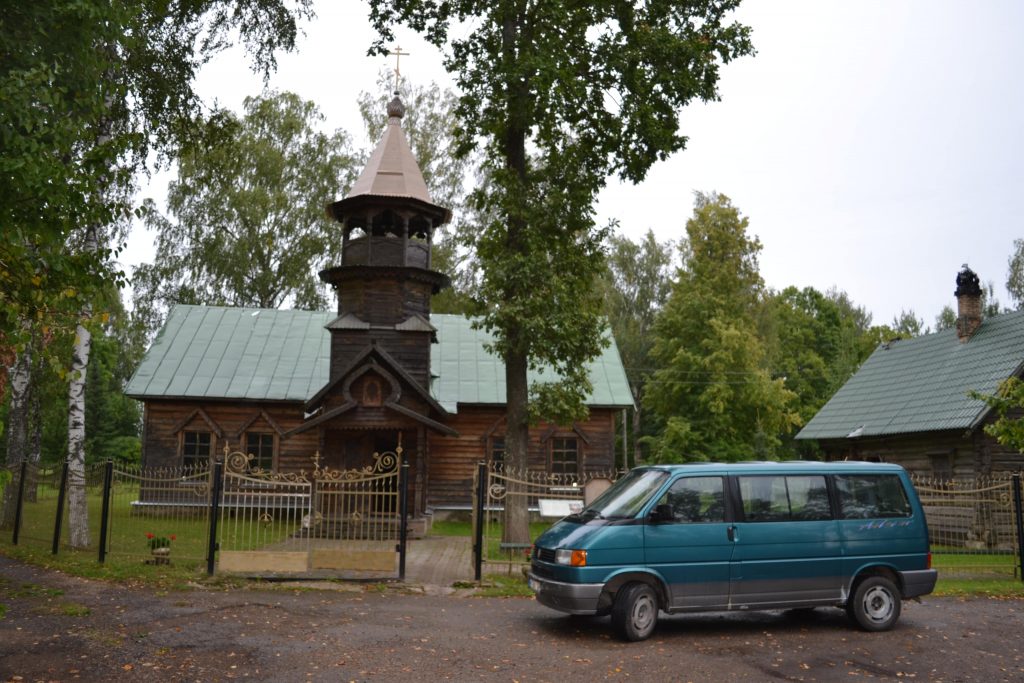
All images credit – Will Mawhood
Will Mawhood is the editor of Deep Baltic
© Deep Baltic 2021. All rights reserved.
Like what Deep Baltic does? Please consider making a monthly donation – help support our writers and in-depth coverage of Estonia, Latvia and Lithuania. Find out more at our Patreon page.

